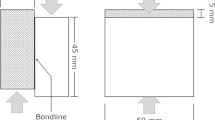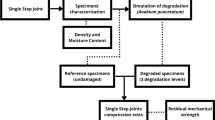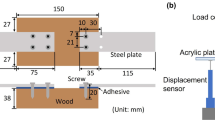Abstract
Shear strength mainly affects the compressive strength of wood and the performance of the wood joint connections. Most studies of failure modes of wood have only focused on bending and tensile properties. Hence, this study focuses on assessing the shear failure modes in pine (Pinus caribaea) softwood and teak (Tectona grandis) hardwood timber species with two joint types: butt and tongue and groove. Most specimens had fractures with fiber failures and wood grain failures on shear test. According to the shear strength values, butt joints are suitable for softwood and tongue-and-groove joints are more suitable for hardwood. Glue line failures only occur in hardwood species. With regard to butt joint, hardwood timber is difficult to bond than softwood timber.



Similar content being viewed by others
References
R. L. Youngs, History of timber use, in Concise Encyclopedia of Wood and Wood Based Materials (Pergamon Press, 1989), pp. 138–143.
C. Jayasinghe, T. Jayasinghe, Sustainable Design of Built Environments (Eco Ceylon Pvt. Ltd, Sri Lanka, 2009), p.42
A.C. Wiedenhoeft, Handbook of Wood Chemistry and Wood Composites, 2nd edn. Structure and Function of Wood, 6000 Broken Sound Parkway, Suite 300 (CRC Press, Taylor & Francis Group, 2013), p. 11
R.B. Hoadley, Understanding Wood: A Craftsman’s Guide to Wood Technology (The Taunton Press, Newtown, 2000), p.75–241
M. Grekin, T. Surini, Shear Strength and Perpendicular-to-Grain Tensile Strength of Defect-Free Scots Pine Wood from Mature Stands in Finland and Sweden. Wood Sci. Technol. 2007(42), 75–91 (2007)
W. Ke-Fu, New Type Connection of Wood Frame and Their Influence to the Performance of Structures (Master’s Thesis, Southeast University, Nanjing, China, 2014), p. 15
]. R. Ning, The Research on the Influence of Wood Microstructure to Fracture (Master’s Thesis, Northeast Forestry University, Harbin, China, 2007)
C. Lei, Z. Zhongfeng, Z. Dan, H. Guojing, C. Jianong, Experimental Research on Fatigue Behavior of Larch Glulam Beams. J. Build. Struct. 2016(37), 27–35 (2016)
C.K. Muthumala, S. De Silva, P.L.A.G. Alwis, K.K.I.U. Arunakumara, Failure Modes and Compression Strength of Seven Finger-Jointed Wood Species from Sri Lanka. J. Fail. Anal. Preven. (2021). https://doi.org/10.1007/s11668-021-01274-9
C.K. Muthumala, S. De Silva, P.L.A.G. Alwis, K.K.I.U. Arunakumara, Evaluation of the Flexural Strength and Failure Modes of Seven Types of Finger Jointed Wood Species. J Fail. Anal. Preven. 22, 680–689 (2022). https://doi.org/10.1007/s11668-022-01358-0
IUFRO, The Global Teak Study, Chapter 6. Wood Quality for Advanced Uses of Teak from Natural and Planted Forests (2017), p. 73
T. Li Hua, L. WenJin, Design Methods of Pine Furniture, Advanced Materials Research Online: 2012-11-29 ISSN: 1662-8985, Vols. 591–593, pp 34–39 (2012). https://doi.org/10.4028/www.scientific.net/AMR.591-593.34
Pedilite, Producer firm, Pidilite Industries ltd, Data sheet. Mumbai, India (2018).
BSI, 1999. BS 373, Methods of Testing Small Clear Specimens of Timber (British Standards Institution, London, 1957). p. 1
C.R. Frihart, C.G. Hunt, Chapter 10: Adhesives with Wood Materials-Bond Formation and Performance, in Wood Handbook—Wood as an Engineering Material. General Technical Report, FPL-GTR-190 (USDA, Forest Service, Forest Products Laboratory, Madison, WI, 2007), pp. 10–1 to 10–24
L. Mingyue, Z. Shuangbao, W. Yurong, R. Haiqing, Effect of Microstructures on the Shear Strength of Larix kaempferi. Forests. 12, 830 (2021). https://doi.org/10.3390/f12070830
Author information
Authors and Affiliations
Corresponding author
Additional information
Publisher's Note
Springer Nature remains neutral with regard to jurisdictional claims in published maps and institutional affiliations.
Rights and permissions
Springer Nature or its licensor (e.g. a society or other partner) holds exclusive rights to this article under a publishing agreement with the author(s) or other rightsholder(s); author self-archiving of the accepted manuscript version of this article is solely governed by the terms of such publishing agreement and applicable law.
About this article
Cite this article
Muthumala, C.K., De Silva, S., Arunakumara, K.K.I.U. et al. Assessment of the Shear Failure Modes of Softwood and Hardwood Timber under Different Wood Joints. J Fail. Anal. and Preven. 23, 1216–1221 (2023). https://doi.org/10.1007/s11668-023-01672-1
Received:
Accepted:
Published:
Issue Date:
DOI: https://doi.org/10.1007/s11668-023-01672-1




